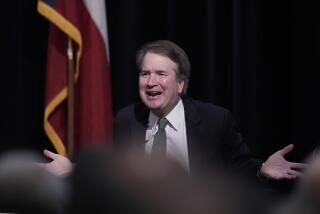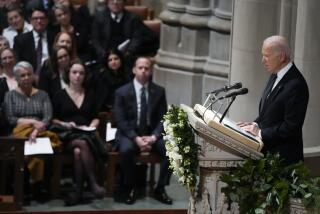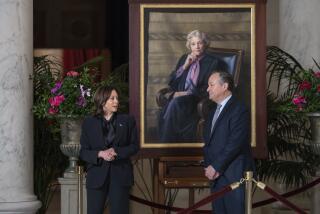A ‘Life Well-Lived’ Is Remembered
WASHINGTON — Chief Justice William H. Rehnquist was remembered by President Bush on Wednesday as a good and gracious man who “earned a place among our greatest chief justices,” while his children recalled a father who always saved time for family and fun.
“No one smelled more roses than my dad,” said James C. Rehnquist, the only son of the chief justice, who died Saturday at age 80.
The funeral at historic St. Matthew’s Cathedral was highlighted by stories describing Rehnquist’s lifelong enthusiasm for games, books, songs, poems, witticisms, bets and geography.
His son noted, however, that Rehnquist was a notoriously fast worker. “It’s easier to strike the proper work-life balance when you can do in an hour or two what most people need a couple of days to do,” he said.
“My father was an incredible optimist,” his daughter Nancy Spears said of the chief justice, who died of thyroid cancer. When the weather outside was bleak, she said, he could be counted upon to check the sky and report back, “It’s clearing in the west.”
Justice Sandra Day O’Connor said she and Rehnquist met as students at Stanford University in 1946, when she was a freshman and he worked as a busboy at her dormitory. A few years later, they were enrolled in the law school, where he was “clearly the brightest student” in their class. Neither imagined they would end up on the Supreme Court together, she said.
She visited with Rehnquist this summer, and said Wednesday that his illness had not taken away his optimism or determination.
“The chief was a betting man,” she told the lawmakers, judges, lawyers and family friends who filled the church. “He enjoyed making wagers about most things: the outcome of football or baseball games, elections, even the amount of snow that would fall in the courtyard at the court....
“I think [he] bet he could live out another term despite his illness,” O’Connor said. “He lost that bet, as did all of us, but he won the prizes for a life well-lived.”
The Supreme Court justices are notoriously independent, but O’Connor said Rehnquist was able to run the court using gentle persuasion.
“I grew up on a ranch. The really expert riders of horses let the horse know immediately who is in control, but then guide the horse with loose reins and very seldom use the spurs,” she said. “So it was with our chief. He guided us with loose reins and used the spurs only rarely to get us up to speed with our work.”
The president described Rehnquist as the rare Washington figure who held a powerful position in government for decades -- he served on the court for 33 years, the last 19 as chief -- but never took on an air of self-importance.
“He carried himself with dignity, but without pretense,” Bush said. “Like Ronald Reagan, the president who elevated him to be chief justice, he was kindly and decent, and there was not an ounce of self-importance about him.”
Bush was accompanied to the service by his wife, Laura, and by Vice President Dick Cheney and his wife, Lynne. The service also drew leaders of the Senate Judiciary Committee and Rehnquist’s former law clerks, including Judge John G. Roberts Jr., who has been tapped by Bush to succeed the chief justice.
St. Matthew’s, a Roman Catholic church, may be best known as the site of President Kennedy’s funeral Mass in 1963. Rehnquist was a member of the Lutheran Church of the Redeemer in suburban McLean, Va., but his family asked to hold the service at the cathedral in downtown Washington to accommodate the large crowd.
Both Rehnquist’s children and O’Connor emphasized the importance of humor in the chief justice’s life.
He “could break up a tense moment with a joke,” O’Connor said.
James Rehnquist said his father was not a true jokester, but instead had a quirky, dry wit. “He could forgive almost everything in a person except being humorless,” he said.
O’Connor said that when Rehnquist recently was rushed to the emergency room at a Virginia hospital, an attendant insisted on knowing his primary-care physician. A faint voice replied, “My dentist.”
Rehnquist liked to make small bets at home too. His daughter Nancy recalled him reading a book in another room and calling out an offer to pay her $5 if she knew the year England’s Queen Elizabeth I had died.
A college student who had studied Elizabethan literature, she answered: “1603.”
“There was silence and a muffled curse,” she said. “Five dollars was not a lot of money ... but my father spent the rest of the summer trying to win it back from me.”
She also recalled his enthusiasm for tennis. He played a regular doubles match with his three law clerks, and usually chose the best player as his partner.
She once asked her father if he chose his law clerks just because they were good tennis players.
“Not at all,” she reported him as replying. “That’s one of several factors.”
A granddaughter, Natalie Ann Rehnquist Lynch, read a letter she had sent to “Gramps” this summer -- one that he had asked that she read at his funeral. In it, she thanked him for all the time he had spent playing card games and croquet with her. She said she even appreciated the geography quizzes that were a regular feature of her visits, and noted that without him, she “would know nothing about bridge or poker or fan-tan, or how to look in the reflection of the window to see the cards of the person sitting across from you.”
Rehnquist’s pastor, the Rev. George W. Evans Jr., said the first hint of the chief justice’s illness came in the summer of 2004, when he reported difficulty in singing the hymns at a Sunday service.
After the two-hour funeral, the chief justice was laid to rest in a private burial at Arlington National Cemetery, next to his wife, Natalie, who died in 1991.
*
(BEGIN TEXT OF INFOBOX)
Justices at Arlington
Chief Justice William H. Rehnquist’s burial at Arlington National Cemetery makes him the fourth Supreme Court chief interred there. Justices buried at Arlington and their terms of service on the high court:
Chief justices
William H. Rehnquist, 1972-2005
Warren E. Burger, 1969-86
Earl Warren, 1953-69
William Howard Taft, 1921-30
Associate justices
Harry A. Blackmun, 1970-94
Thurgood Marshall, 1967-91
Arthur J. Goldberg, 1962-65
Potter Stewart, 1958-81
William J. Brennan, 1956-90
William O. Douglas, 1939-75
Hugo L. Black, 1937-71
Oliver Wendell Holmes Jr., 1902-32
Sources: Arlington National Cemetery, Supreme Court
Graphics reporting by Tom Reinken
More to Read
Get the L.A. Times Politics newsletter
Deeply reported insights into legislation, politics and policy from Sacramento, Washington and beyond. In your inbox three times per week.
You may occasionally receive promotional content from the Los Angeles Times.











